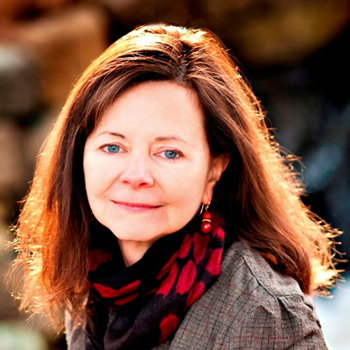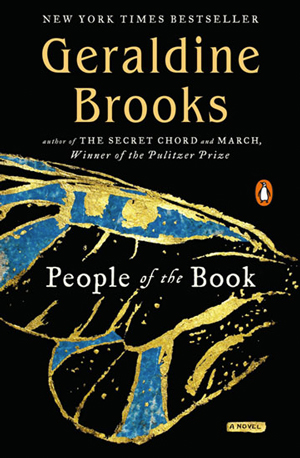by Mike Telin

Ključo’s work was inspired by Brooks’s 2008 historical novel People of the Book. In an interview with this publication, Ključo said, “I got inspired by this amazing book and became obsessed with the idea of the project that would musically and visually follow the Haggadah’s journey from Spain to Sarajevo.”
Surprisingly, Brooks, who will introduce Wednesday’s concert, did not meet Ključo until she was asked to say a few words about the story and take part in a Q&A following a performance in Boston. “I was very happy to do so,” the Australian native said, “but I had no idea what an experience it was going to be. The performance absolutely blew my hair back. It’s such an inspiring piece of music. I wasn’t familiar with the accordion as a concert instrument, but Ključo makes it breathe, she makes it thunder, and she uses it to convey all of the different musical traditions that the Haggadah has traveled through. Then there is the beautiful video that draws on the artistry of the Haggadah itself, but interweaves some extremely dramatic visual elements that convey the horrors of the Holocaust and the Bosnian war. It’s really an immersive experience. It’s haunting and exhilarating, and really moving.”
During her introductory remarks, Brooks will talk about the history of the Sarajevo Haggadah, and how it has inspired so many people through the centuries. A book signing will follow the performance.
The Sydney-born author said that she looks forward to returning to Cleveland, which was her first posting as a rookie with The Wall Street Journal. “I was at the journalism school at Columbia University, and the Journal hired me for the Cleveland bureau. Having grown up in Australia I thought it was great. I left this basic squat in New York and rented a gorgeous apartment in Shaker Square. I thought I had gone to heaven — until winter came. I was there just one year, then I went over to the foreign desk for the rest of my career with them.”
Brooks first encountered the tale of the Sarajevo Haggadah while covering the siege of the city as a correspondent for The Wall Street Journal. “It was brutal even by the standards of war, because it was essentially a war against civilians. There was only one functioning hotel, the rather inaptly named Holiday Inn, so that was where all the reporters had to stay. We would gather at the end of the day and swap stories, until one night the talk turned to this missing treasure of the Bosnian National Museum — this priceless Hebrew illuminated manuscript — and nobody knew where it was,” Brooks recalled. “You know what reporters are like, so there was all kinds of speculation. Some said that it had been sold on the black market, another said the Israelis had come and taken it. It went on like that, and then a couple of years later the true story was revealed, which was even more remarkable — that a Muslim librarian had risked his life to save this Jewish book.”
As the details of the story of the Sarajevo Haggadah began to unfold, Brooks became more and more intrigued. The book had been saved by a Muslim during World War II. Earlier, it had been saved by a Catholic priest in Venice in 1609, and still earlier during the expulsion of the Jews from Spain in the late 1400s.
The novelist said that the idea for the book came about sometime in the late 1990s. “I didn’t know how I was going to weave it all together, but I knew that I wanted to spend some time with the Haggadah. It’s very hard to get to see it, so when I heard that the United Nations was funding a conservator to do some repairs on the manuscript, I asked if I could be in the room. So I sat there while she essentially took the book apart and put it back together.”
Using the same techniques she used as a journalist, Brooks began her fact-checking research in the present, interviewing everyone who had been involved with the book who was alive during the Sarajevo siege. However, gathering facts for the Haggadah’s story during World War II became more difficult. “I was frustrated by how many different accounts of the story there were. Then I tracked down a relative of the librarian who had saved the book. She was very kind and agreed to meet with me. After sharing some family documents she said, ‘If you really want to know what happened when Uncle saved the manuscript, you should talk to his wife who lives in Sarajevo.’ I nearly fell off my chair, because I had no idea that a man who was in his 60s during the war would have a widow who was still alive in the 1990s. My ticket to Sarajevo was bought and paid for before I left the room.”
Brooks was able to meet with the widow, who told her how her husband had prevented the Nazis from seizing the book by putting it in the waistband of his pants and bringing it home, and later deciding to hide it at his friend’s mosque.
In The People of the Book, Brooks describes in detail the restoration process actually used by the conservator. “That’s very close to what happened, but what surprised me is the detective work that’s involved. Any speck of matter that’s caught in the binding they send away for chemical analysis — you can find out a lot from a crumb. I fictionalized the kinds of things that you might find, like a bit of an insect wing, and each of these little things takes you on a journey back in time to meet the person who was responsible for either creating or protecting the book through history.”
Brooks remembered her shock when she first saw the historic manuscript. “It was rebound in Vienna in the 1890s and they did a terrible job. If you saw it at a yard sale you probably wouldn’t pick it up. But when the conservator opened it to the first illumination, I said, wow! The colors look just as vivid as they were the day they were painted. It’s the old pigment. The blues are made from lapis lazuli, so it’s quite extraordinary.”
Before we ended our conversation, I asked the award-winning journalist to share her thoughts about the ever-changing face of the media in our up-to-the-minute world. “What was great about The Wall Street Journal in the years that I worked there was that we had a very deep bench of editors who would look over our copy and send it back if we hadn’t completely reported something. That allowed the newspaper to hire young reporters like myself. But I think the gain today is that we can get unmediated information. We might not have been able to find out the truth about Abu Ghraib if it were not for the proliferation of channels for getting the story out. Otherwise it might have been many years before the truth emerged. I’d be very sorry if the old media were to be completely crushed, because I think you end up in your own silo only listening to the opinions that you already agree with. I think it’s good to have a broad range of voices.”
On Tuesday, October 27 at 7:00 pm at the Parma branch of the Cuyahoga Public Library, Geraldine Brooks will also talk about her latest historical novel, The Secret Chord, about King David. The title is inspired by Leonard Cohen’s classic song Hallelujah. “There’s a line in the song that goes, ‘Now I’ve heard there was a secret chord that David played, and it pleased the Lord.’ But there’s a line later in the song. ‘There’s a blaze of light in every word, it doesn’t matter which you heard, the holy or the broken hallelujah.’ To me that encompasses David’s duality as a man who contains both the darkest and the lightest qualities of a human being. He’s a great artist but also a killer. A lover, a murderer, a great leader who’s also desperate. I think that Leonard Cohen, with his usual poetic insight, tells us why we’re still fascinated by David three thousand years later.” A Q&A and book signing will follow the presentation.
Published on ClevelandClassical.com October 26, 2015.
Click here for a printable copy of this article





